Conceptual Framework of Accounting and Telstra Financial Analysis
VerifiedAdded on 2020/03/23
|9
|2228
|121
Report
AI Summary
This report provides an executive summary of the accounting conceptual framework and general-purpose financial statements, emphasizing their role in financial statement preparation and day-to-day accounting operations. It delves into the qualitative characteristics of accounting and analyzes Telstra, a company listed on the ASX, to assess its compliance with disclosure requirements for Property, Plant, and Equipment (PPE). The report discusses the framework's importance for both internal and external users, the valuation and reporting requirements guided by AASB 116, and the specific disclosures made by Telstra in its annual report. Furthermore, it examines the qualitative characteristics of financial reporting, such as faithful representation and comparability, and concludes with recommendations for enhancing reporting practices and increasing transparency in financial statements. The report also includes references to relevant academic literature.
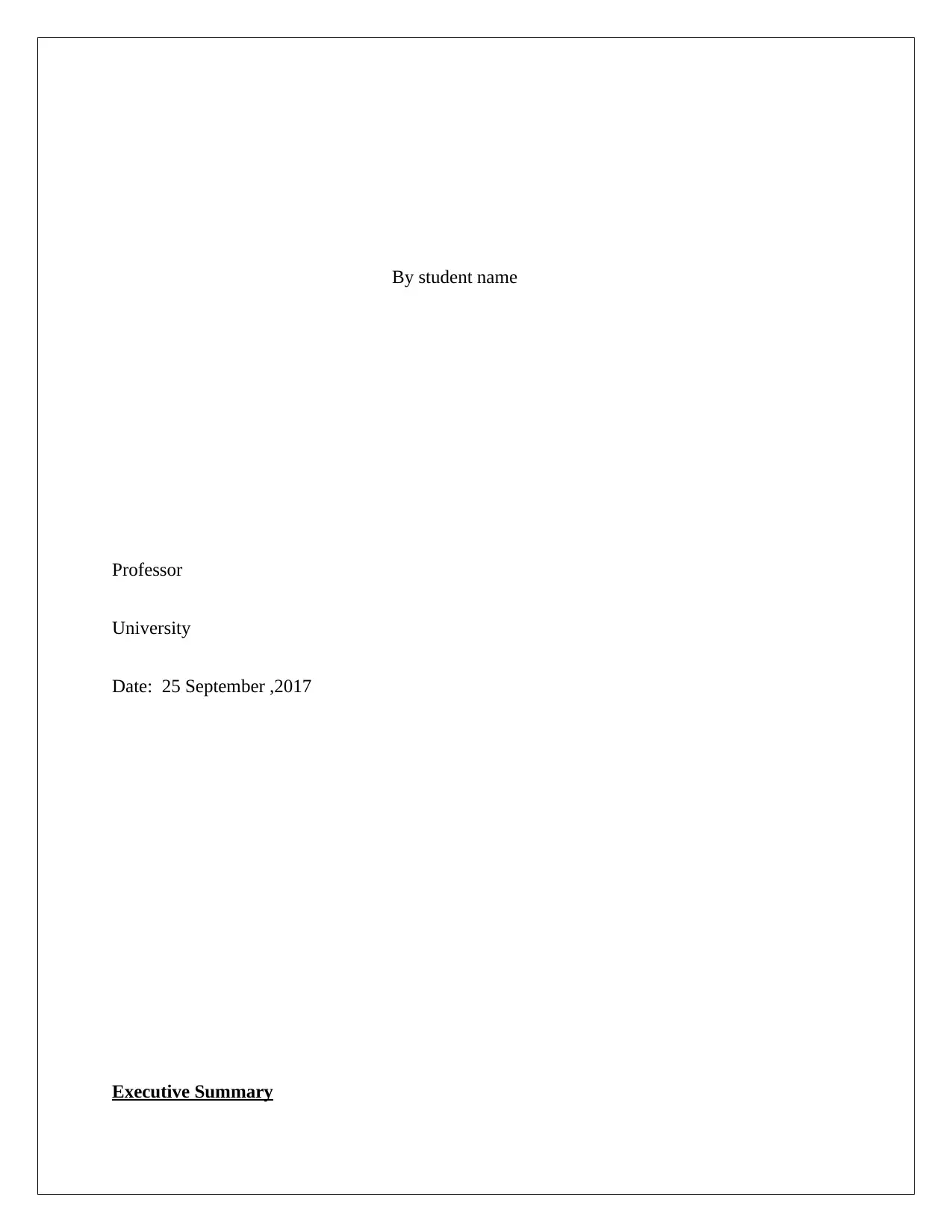
By student name
Professor
University
Date: 25 September ,2017
Executive Summary
Professor
University
Date: 25 September ,2017
Executive Summary
Paraphrase This Document
Need a fresh take? Get an instant paraphrase of this document with our AI Paraphraser
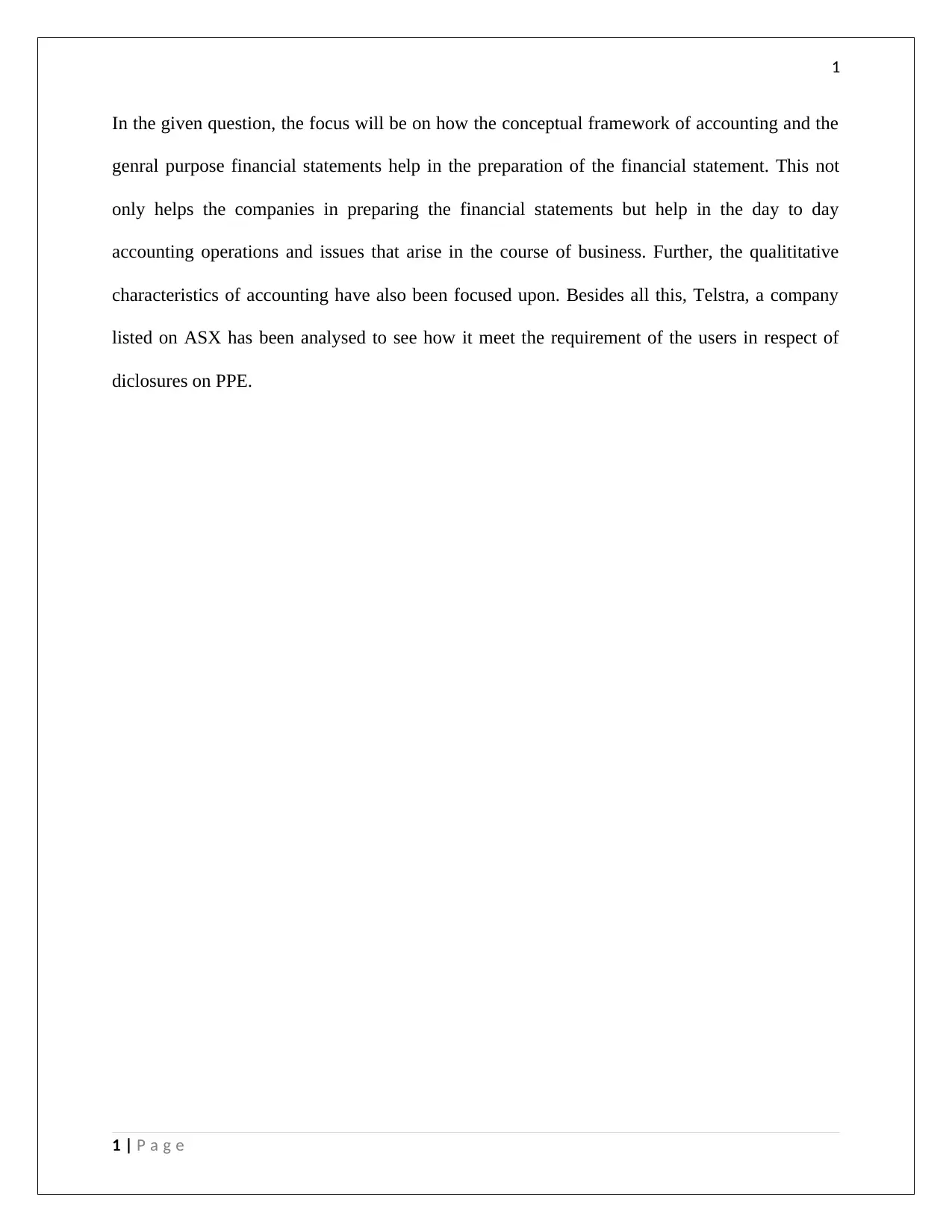
1
In the given question, the focus will be on how the conceptual framework of accounting and the
genral purpose financial statements help in the preparation of the financial statement. This not
only helps the companies in preparing the financial statements but help in the day to day
accounting operations and issues that arise in the course of business. Further, the qualititative
characteristics of accounting have also been focused upon. Besides all this, Telstra, a company
listed on ASX has been analysed to see how it meet the requirement of the users in respect of
diclosures on PPE.
1 | P a g e
In the given question, the focus will be on how the conceptual framework of accounting and the
genral purpose financial statements help in the preparation of the financial statement. This not
only helps the companies in preparing the financial statements but help in the day to day
accounting operations and issues that arise in the course of business. Further, the qualititative
characteristics of accounting have also been focused upon. Besides all this, Telstra, a company
listed on ASX has been analysed to see how it meet the requirement of the users in respect of
diclosures on PPE.
1 | P a g e
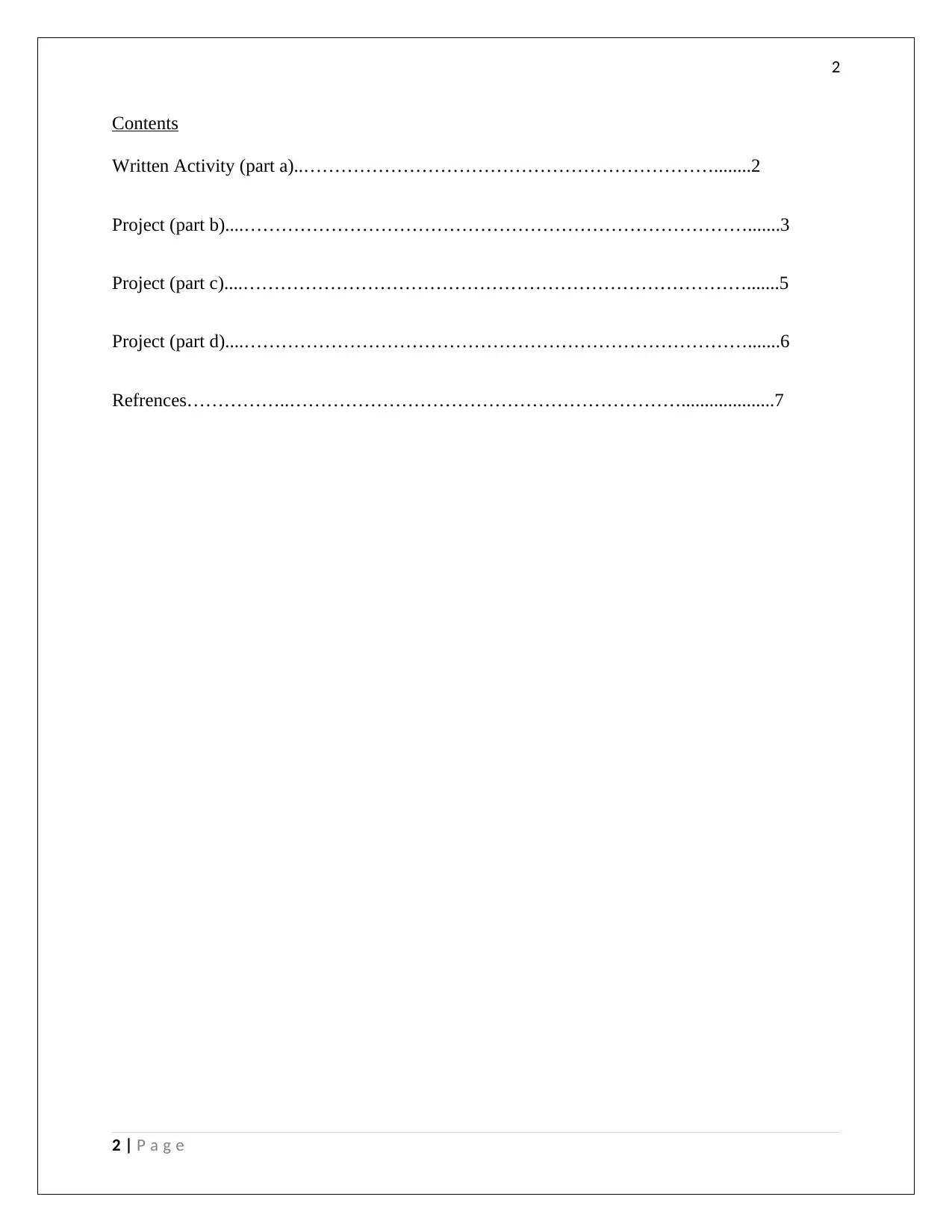
2
Contents
Written Activity (part a)..…………………………………………………………........2
Project (part b)....……………………………………………………………………….......3
Project (part c)....……………………………………………………………………….......5
Project (part d)....……………………………………………………………………….......6
Refrences……………..………………………………………………………....................7
2 | P a g e
Contents
Written Activity (part a)..…………………………………………………………........2
Project (part b)....……………………………………………………………………….......3
Project (part c)....……………………………………………………………………….......5
Project (part d)....……………………………………………………………………….......6
Refrences……………..………………………………………………………....................7
2 | P a g e
⊘ This is a preview!⊘
Do you want full access?
Subscribe today to unlock all pages.

Trusted by 1+ million students worldwide
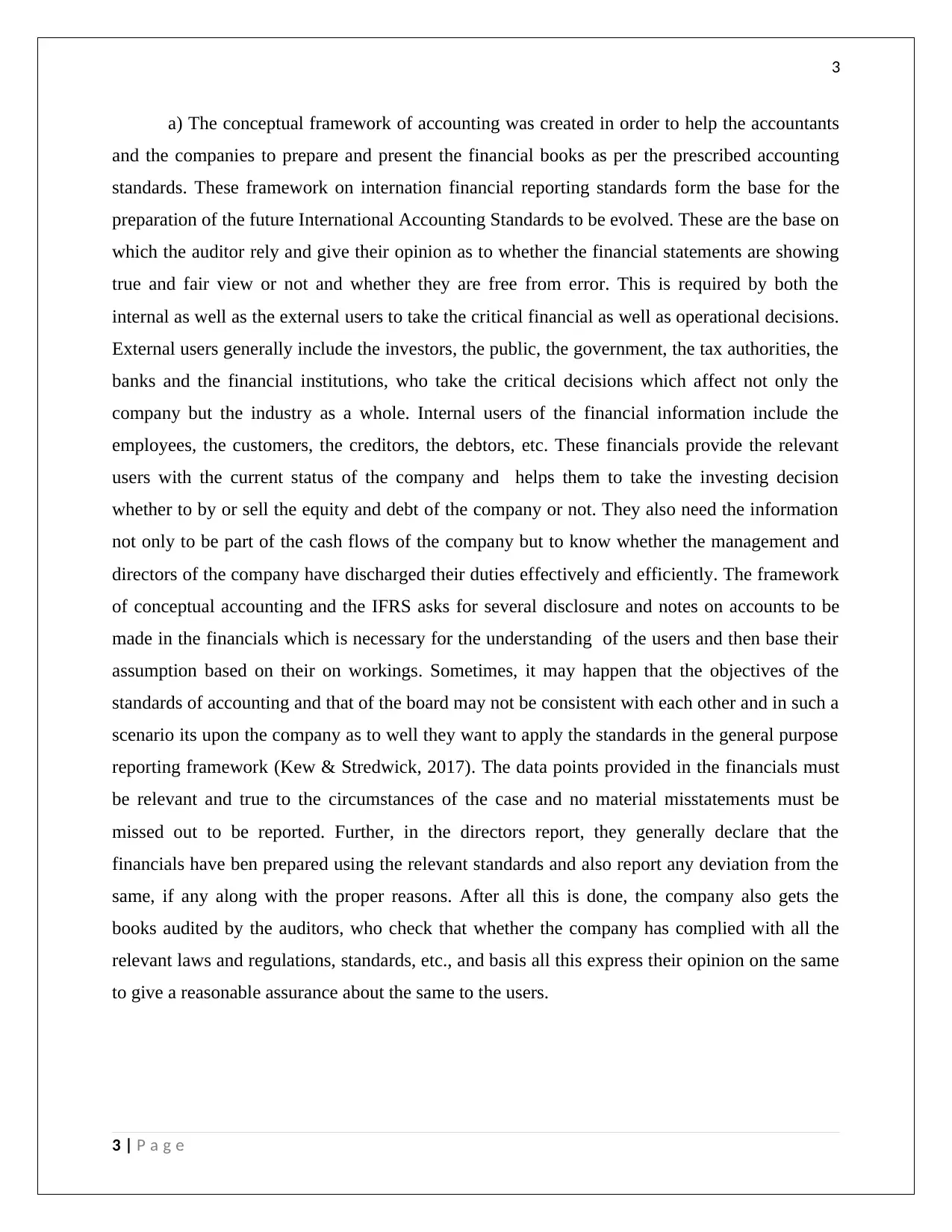
3
a) The conceptual framework of accounting was created in order to help the accountants
and the companies to prepare and present the financial books as per the prescribed accounting
standards. These framework on internation financial reporting standards form the base for the
preparation of the future International Accounting Standards to be evolved. These are the base on
which the auditor rely and give their opinion as to whether the financial statements are showing
true and fair view or not and whether they are free from error. This is required by both the
internal as well as the external users to take the critical financial as well as operational decisions.
External users generally include the investors, the public, the government, the tax authorities, the
banks and the financial institutions, who take the critical decisions which affect not only the
company but the industry as a whole. Internal users of the financial information include the
employees, the customers, the creditors, the debtors, etc. These financials provide the relevant
users with the current status of the company and helps them to take the investing decision
whether to by or sell the equity and debt of the company or not. They also need the information
not only to be part of the cash flows of the company but to know whether the management and
directors of the company have discharged their duties effectively and efficiently. The framework
of conceptual accounting and the IFRS asks for several disclosure and notes on accounts to be
made in the financials which is necessary for the understanding of the users and then base their
assumption based on their on workings. Sometimes, it may happen that the objectives of the
standards of accounting and that of the board may not be consistent with each other and in such a
scenario its upon the company as to well they want to apply the standards in the general purpose
reporting framework (Kew & Stredwick, 2017). The data points provided in the financials must
be relevant and true to the circumstances of the case and no material misstatements must be
missed out to be reported. Further, in the directors report, they generally declare that the
financials have ben prepared using the relevant standards and also report any deviation from the
same, if any along with the proper reasons. After all this is done, the company also gets the
books audited by the auditors, who check that whether the company has complied with all the
relevant laws and regulations, standards, etc., and basis all this express their opinion on the same
to give a reasonable assurance about the same to the users.
3 | P a g e
a) The conceptual framework of accounting was created in order to help the accountants
and the companies to prepare and present the financial books as per the prescribed accounting
standards. These framework on internation financial reporting standards form the base for the
preparation of the future International Accounting Standards to be evolved. These are the base on
which the auditor rely and give their opinion as to whether the financial statements are showing
true and fair view or not and whether they are free from error. This is required by both the
internal as well as the external users to take the critical financial as well as operational decisions.
External users generally include the investors, the public, the government, the tax authorities, the
banks and the financial institutions, who take the critical decisions which affect not only the
company but the industry as a whole. Internal users of the financial information include the
employees, the customers, the creditors, the debtors, etc. These financials provide the relevant
users with the current status of the company and helps them to take the investing decision
whether to by or sell the equity and debt of the company or not. They also need the information
not only to be part of the cash flows of the company but to know whether the management and
directors of the company have discharged their duties effectively and efficiently. The framework
of conceptual accounting and the IFRS asks for several disclosure and notes on accounts to be
made in the financials which is necessary for the understanding of the users and then base their
assumption based on their on workings. Sometimes, it may happen that the objectives of the
standards of accounting and that of the board may not be consistent with each other and in such a
scenario its upon the company as to well they want to apply the standards in the general purpose
reporting framework (Kew & Stredwick, 2017). The data points provided in the financials must
be relevant and true to the circumstances of the case and no material misstatements must be
missed out to be reported. Further, in the directors report, they generally declare that the
financials have ben prepared using the relevant standards and also report any deviation from the
same, if any along with the proper reasons. After all this is done, the company also gets the
books audited by the auditors, who check that whether the company has complied with all the
relevant laws and regulations, standards, etc., and basis all this express their opinion on the same
to give a reasonable assurance about the same to the users.
3 | P a g e
Paraphrase This Document
Need a fresh take? Get an instant paraphrase of this document with our AI Paraphraser
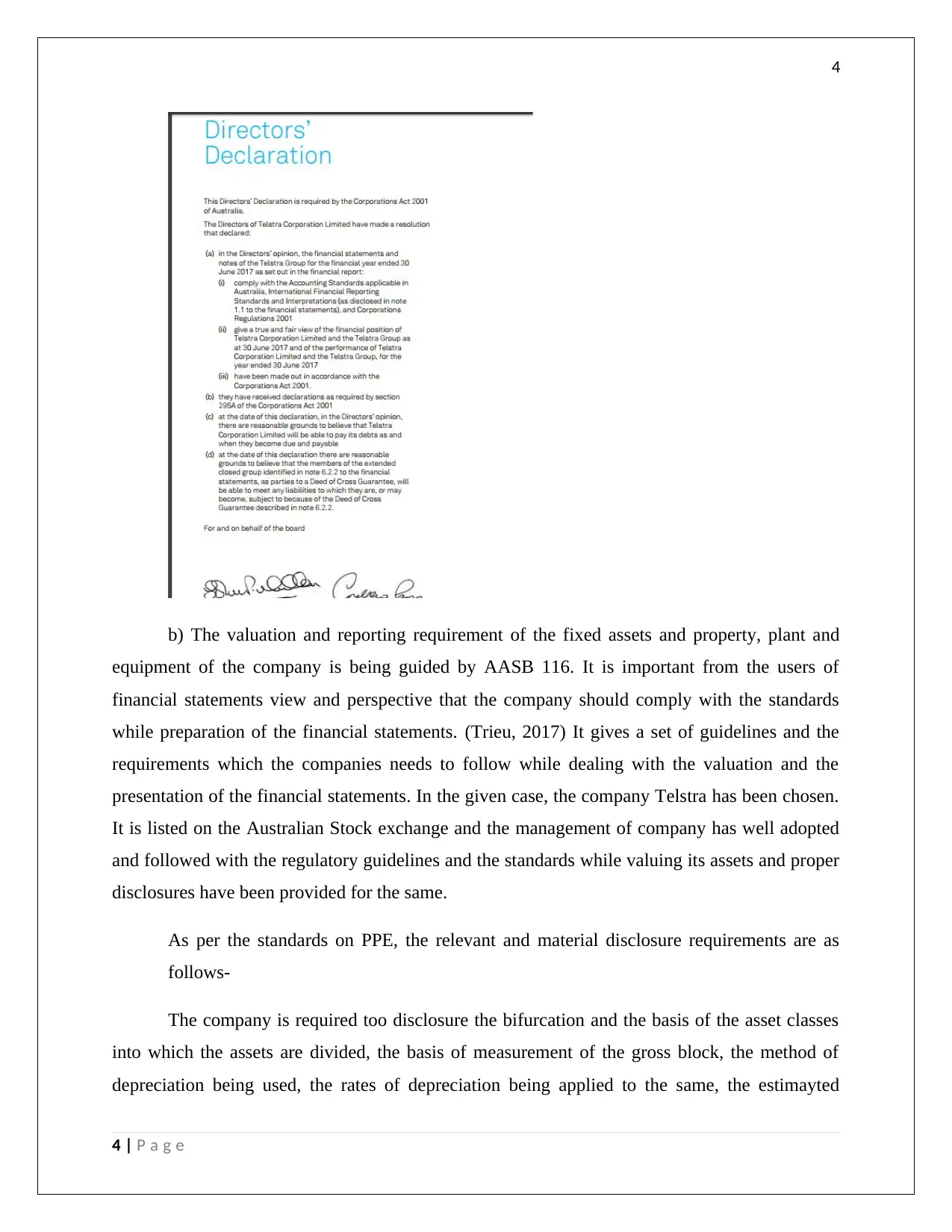
4
b) The valuation and reporting requirement of the fixed assets and property, plant and
equipment of the company is being guided by AASB 116. It is important from the users of
financial statements view and perspective that the company should comply with the standards
while preparation of the financial statements. (Trieu, 2017) It gives a set of guidelines and the
requirements which the companies needs to follow while dealing with the valuation and the
presentation of the financial statements. In the given case, the company Telstra has been chosen.
It is listed on the Australian Stock exchange and the management of company has well adopted
and followed with the regulatory guidelines and the standards while valuing its assets and proper
disclosures have been provided for the same.
As per the standards on PPE, the relevant and material disclosure requirements are as
follows-
The company is required too disclosure the bifurcation and the basis of the asset classes
into which the assets are divided, the basis of measurement of the gross block, the method of
depreciation being used, the rates of depreciation being applied to the same, the estimayted
4 | P a g e
b) The valuation and reporting requirement of the fixed assets and property, plant and
equipment of the company is being guided by AASB 116. It is important from the users of
financial statements view and perspective that the company should comply with the standards
while preparation of the financial statements. (Trieu, 2017) It gives a set of guidelines and the
requirements which the companies needs to follow while dealing with the valuation and the
presentation of the financial statements. In the given case, the company Telstra has been chosen.
It is listed on the Australian Stock exchange and the management of company has well adopted
and followed with the regulatory guidelines and the standards while valuing its assets and proper
disclosures have been provided for the same.
As per the standards on PPE, the relevant and material disclosure requirements are as
follows-
The company is required too disclosure the bifurcation and the basis of the asset classes
into which the assets are divided, the basis of measurement of the gross block, the method of
depreciation being used, the rates of depreciation being applied to the same, the estimayted
4 | P a g e
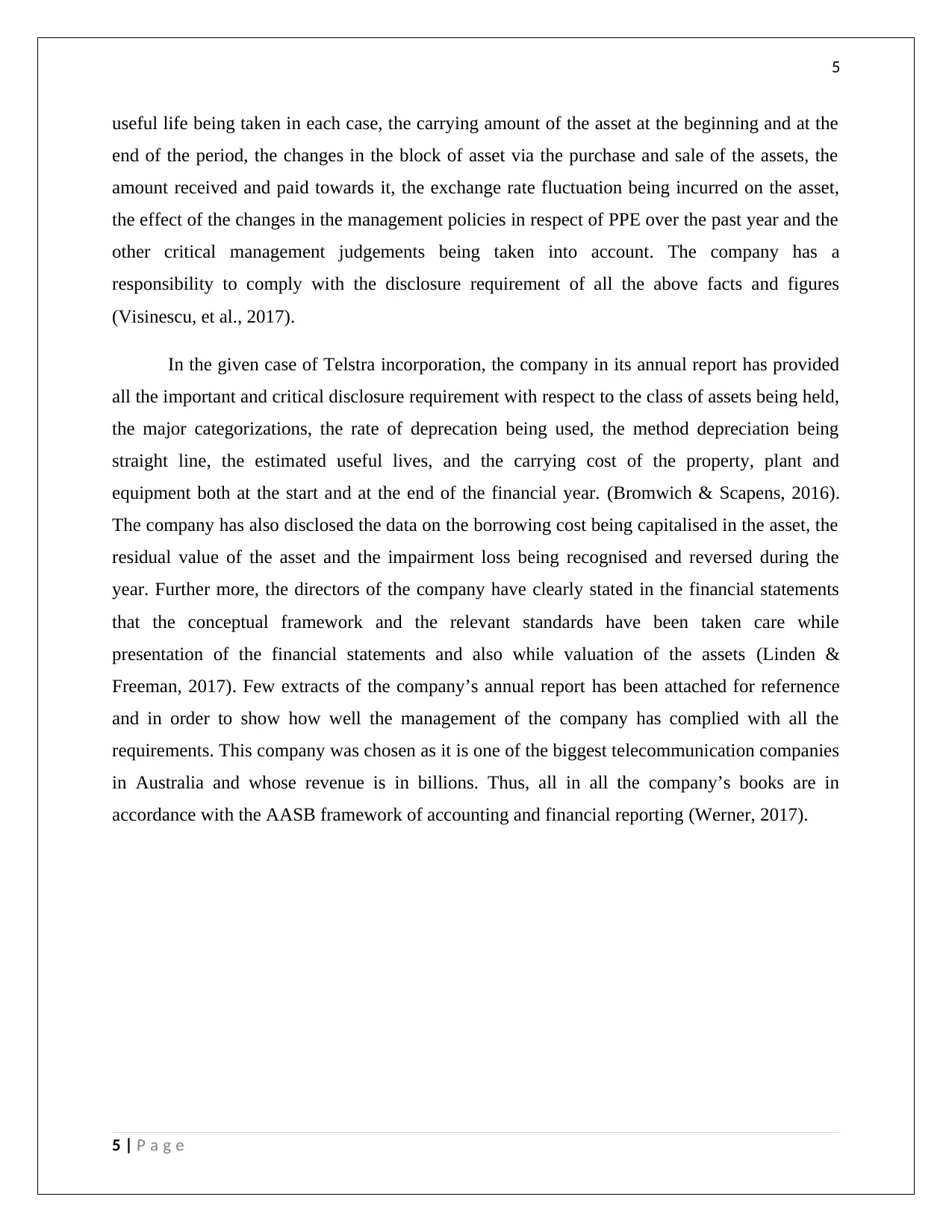
5
useful life being taken in each case, the carrying amount of the asset at the beginning and at the
end of the period, the changes in the block of asset via the purchase and sale of the assets, the
amount received and paid towards it, the exchange rate fluctuation being incurred on the asset,
the effect of the changes in the management policies in respect of PPE over the past year and the
other critical management judgements being taken into account. The company has a
responsibility to comply with the disclosure requirement of all the above facts and figures
(Visinescu, et al., 2017).
In the given case of Telstra incorporation, the company in its annual report has provided
all the important and critical disclosure requirement with respect to the class of assets being held,
the major categorizations, the rate of deprecation being used, the method depreciation being
straight line, the estimated useful lives, and the carrying cost of the property, plant and
equipment both at the start and at the end of the financial year. (Bromwich & Scapens, 2016).
The company has also disclosed the data on the borrowing cost being capitalised in the asset, the
residual value of the asset and the impairment loss being recognised and reversed during the
year. Further more, the directors of the company have clearly stated in the financial statements
that the conceptual framework and the relevant standards have been taken care while
presentation of the financial statements and also while valuation of the assets (Linden &
Freeman, 2017). Few extracts of the company’s annual report has been attached for refernence
and in order to show how well the management of the company has complied with all the
requirements. This company was chosen as it is one of the biggest telecommunication companies
in Australia and whose revenue is in billions. Thus, all in all the company’s books are in
accordance with the AASB framework of accounting and financial reporting (Werner, 2017).
5 | P a g e
useful life being taken in each case, the carrying amount of the asset at the beginning and at the
end of the period, the changes in the block of asset via the purchase and sale of the assets, the
amount received and paid towards it, the exchange rate fluctuation being incurred on the asset,
the effect of the changes in the management policies in respect of PPE over the past year and the
other critical management judgements being taken into account. The company has a
responsibility to comply with the disclosure requirement of all the above facts and figures
(Visinescu, et al., 2017).
In the given case of Telstra incorporation, the company in its annual report has provided
all the important and critical disclosure requirement with respect to the class of assets being held,
the major categorizations, the rate of deprecation being used, the method depreciation being
straight line, the estimated useful lives, and the carrying cost of the property, plant and
equipment both at the start and at the end of the financial year. (Bromwich & Scapens, 2016).
The company has also disclosed the data on the borrowing cost being capitalised in the asset, the
residual value of the asset and the impairment loss being recognised and reversed during the
year. Further more, the directors of the company have clearly stated in the financial statements
that the conceptual framework and the relevant standards have been taken care while
presentation of the financial statements and also while valuation of the assets (Linden &
Freeman, 2017). Few extracts of the company’s annual report has been attached for refernence
and in order to show how well the management of the company has complied with all the
requirements. This company was chosen as it is one of the biggest telecommunication companies
in Australia and whose revenue is in billions. Thus, all in all the company’s books are in
accordance with the AASB framework of accounting and financial reporting (Werner, 2017).
5 | P a g e
⊘ This is a preview!⊘
Do you want full access?
Subscribe today to unlock all pages.

Trusted by 1+ million students worldwide
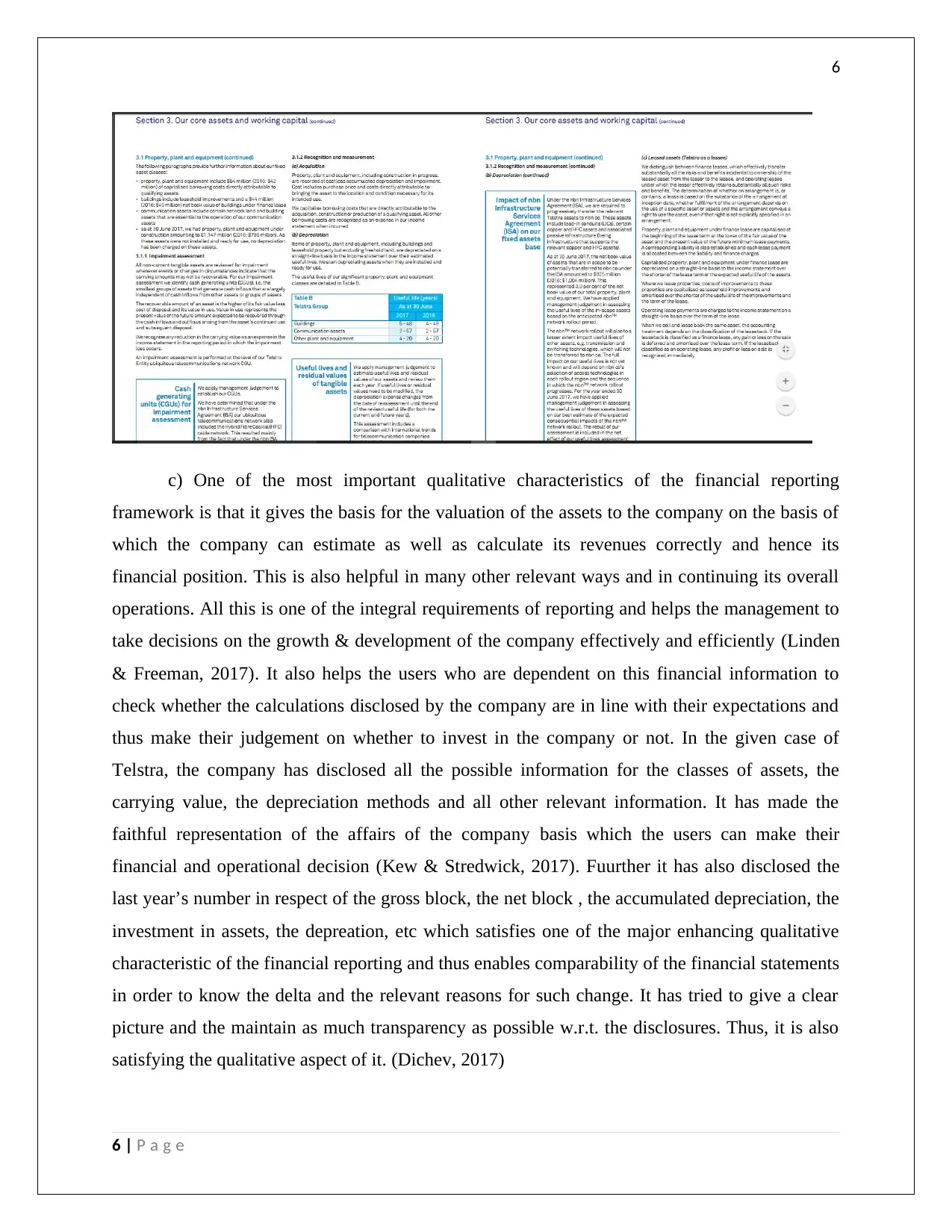
6
c) One of the most important qualitative characteristics of the financial reporting
framework is that it gives the basis for the valuation of the assets to the company on the basis of
which the company can estimate as well as calculate its revenues correctly and hence its
financial position. This is also helpful in many other relevant ways and in continuing its overall
operations. All this is one of the integral requirements of reporting and helps the management to
take decisions on the growth & development of the company effectively and efficiently (Linden
& Freeman, 2017). It also helps the users who are dependent on this financial information to
check whether the calculations disclosed by the company are in line with their expectations and
thus make their judgement on whether to invest in the company or not. In the given case of
Telstra, the company has disclosed all the possible information for the classes of assets, the
carrying value, the depreciation methods and all other relevant information. It has made the
faithful representation of the affairs of the company basis which the users can make their
financial and operational decision (Kew & Stredwick, 2017). Fuurther it has also disclosed the
last year’s number in respect of the gross block, the net block , the accumulated depreciation, the
investment in assets, the depreation, etc which satisfies one of the major enhancing qualitative
characteristic of the financial reporting and thus enables comparability of the financial statements
in order to know the delta and the relevant reasons for such change. It has tried to give a clear
picture and the maintain as much transparency as possible w.r.t. the disclosures. Thus, it is also
satisfying the qualitative aspect of it. (Dichev, 2017)
6 | P a g e
c) One of the most important qualitative characteristics of the financial reporting
framework is that it gives the basis for the valuation of the assets to the company on the basis of
which the company can estimate as well as calculate its revenues correctly and hence its
financial position. This is also helpful in many other relevant ways and in continuing its overall
operations. All this is one of the integral requirements of reporting and helps the management to
take decisions on the growth & development of the company effectively and efficiently (Linden
& Freeman, 2017). It also helps the users who are dependent on this financial information to
check whether the calculations disclosed by the company are in line with their expectations and
thus make their judgement on whether to invest in the company or not. In the given case of
Telstra, the company has disclosed all the possible information for the classes of assets, the
carrying value, the depreciation methods and all other relevant information. It has made the
faithful representation of the affairs of the company basis which the users can make their
financial and operational decision (Kew & Stredwick, 2017). Fuurther it has also disclosed the
last year’s number in respect of the gross block, the net block , the accumulated depreciation, the
investment in assets, the depreation, etc which satisfies one of the major enhancing qualitative
characteristic of the financial reporting and thus enables comparability of the financial statements
in order to know the delta and the relevant reasons for such change. It has tried to give a clear
picture and the maintain as much transparency as possible w.r.t. the disclosures. Thus, it is also
satisfying the qualitative aspect of it. (Dichev, 2017)
6 | P a g e
Paraphrase This Document
Need a fresh take? Get an instant paraphrase of this document with our AI Paraphraser
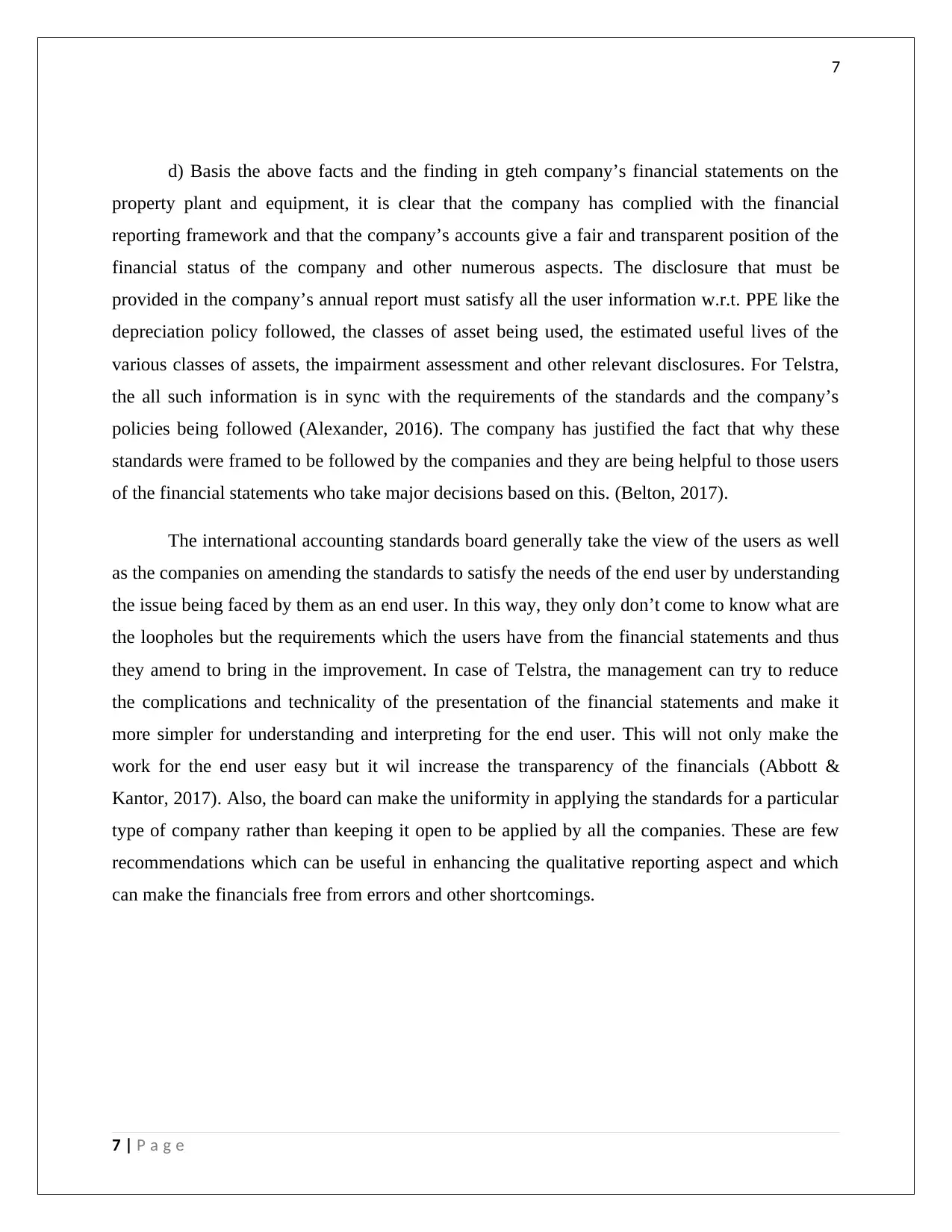
7
d) Basis the above facts and the finding in gteh company’s financial statements on the
property plant and equipment, it is clear that the company has complied with the financial
reporting framework and that the company’s accounts give a fair and transparent position of the
financial status of the company and other numerous aspects. The disclosure that must be
provided in the company’s annual report must satisfy all the user information w.r.t. PPE like the
depreciation policy followed, the classes of asset being used, the estimated useful lives of the
various classes of assets, the impairment assessment and other relevant disclosures. For Telstra,
the all such information is in sync with the requirements of the standards and the company’s
policies being followed (Alexander, 2016). The company has justified the fact that why these
standards were framed to be followed by the companies and they are being helpful to those users
of the financial statements who take major decisions based on this. (Belton, 2017).
The international accounting standards board generally take the view of the users as well
as the companies on amending the standards to satisfy the needs of the end user by understanding
the issue being faced by them as an end user. In this way, they only don’t come to know what are
the loopholes but the requirements which the users have from the financial statements and thus
they amend to bring in the improvement. In case of Telstra, the management can try to reduce
the complications and technicality of the presentation of the financial statements and make it
more simpler for understanding and interpreting for the end user. This will not only make the
work for the end user easy but it wil increase the transparency of the financials (Abbott &
Kantor, 2017). Also, the board can make the uniformity in applying the standards for a particular
type of company rather than keeping it open to be applied by all the companies. These are few
recommendations which can be useful in enhancing the qualitative reporting aspect and which
can make the financials free from errors and other shortcomings.
7 | P a g e
d) Basis the above facts and the finding in gteh company’s financial statements on the
property plant and equipment, it is clear that the company has complied with the financial
reporting framework and that the company’s accounts give a fair and transparent position of the
financial status of the company and other numerous aspects. The disclosure that must be
provided in the company’s annual report must satisfy all the user information w.r.t. PPE like the
depreciation policy followed, the classes of asset being used, the estimated useful lives of the
various classes of assets, the impairment assessment and other relevant disclosures. For Telstra,
the all such information is in sync with the requirements of the standards and the company’s
policies being followed (Alexander, 2016). The company has justified the fact that why these
standards were framed to be followed by the companies and they are being helpful to those users
of the financial statements who take major decisions based on this. (Belton, 2017).
The international accounting standards board generally take the view of the users as well
as the companies on amending the standards to satisfy the needs of the end user by understanding
the issue being faced by them as an end user. In this way, they only don’t come to know what are
the loopholes but the requirements which the users have from the financial statements and thus
they amend to bring in the improvement. In case of Telstra, the management can try to reduce
the complications and technicality of the presentation of the financial statements and make it
more simpler for understanding and interpreting for the end user. This will not only make the
work for the end user easy but it wil increase the transparency of the financials (Abbott &
Kantor, 2017). Also, the board can make the uniformity in applying the standards for a particular
type of company rather than keeping it open to be applied by all the companies. These are few
recommendations which can be useful in enhancing the qualitative reporting aspect and which
can make the financials free from errors and other shortcomings.
7 | P a g e
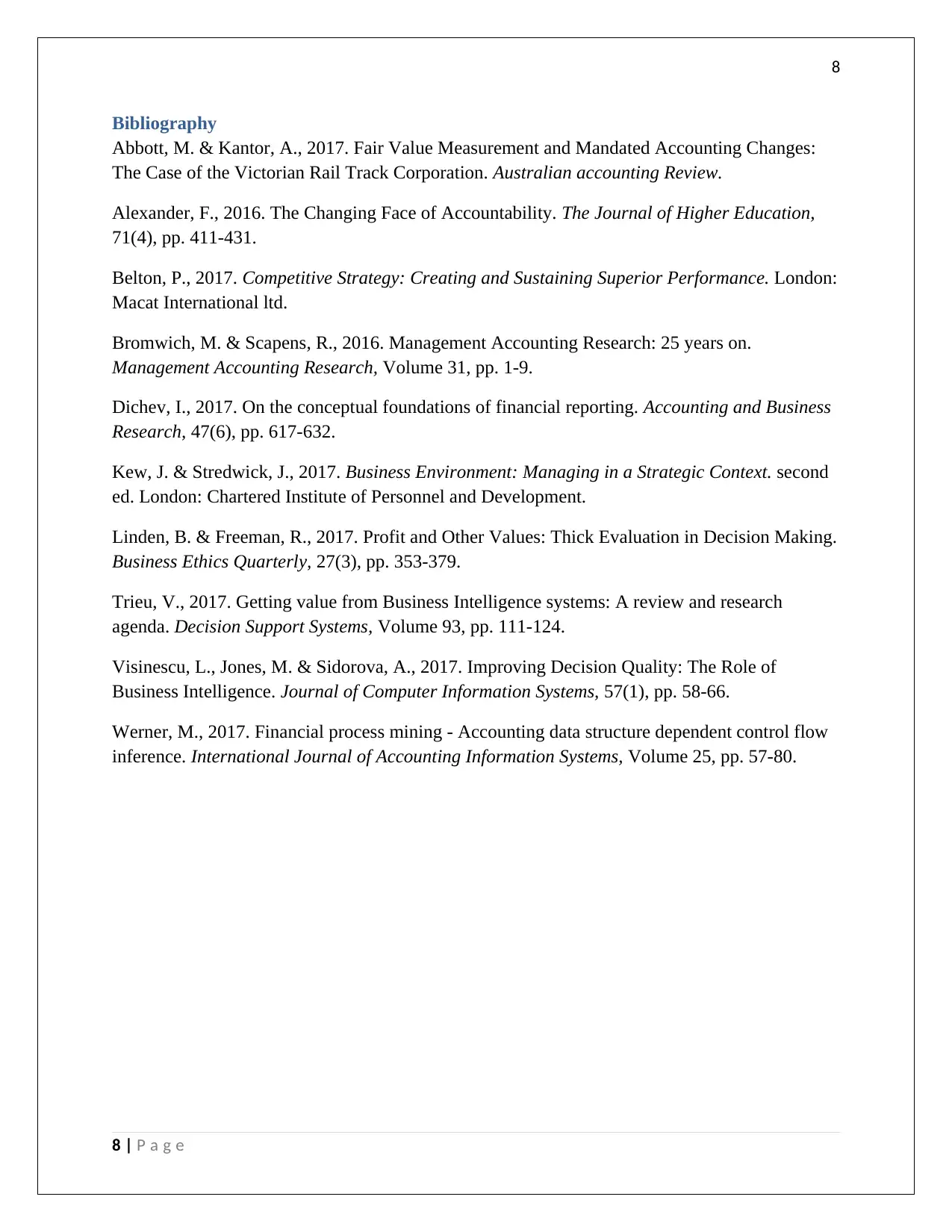
8
Bibliography
Abbott, M. & Kantor, A., 2017. Fair Value Measurement and Mandated Accounting Changes:
The Case of the Victorian Rail Track Corporation. Australian accounting Review.
Alexander, F., 2016. The Changing Face of Accountability. The Journal of Higher Education,
71(4), pp. 411-431.
Belton, P., 2017. Competitive Strategy: Creating and Sustaining Superior Performance. London:
Macat International ltd.
Bromwich, M. & Scapens, R., 2016. Management Accounting Research: 25 years on.
Management Accounting Research, Volume 31, pp. 1-9.
Dichev, I., 2017. On the conceptual foundations of financial reporting. Accounting and Business
Research, 47(6), pp. 617-632.
Kew, J. & Stredwick, J., 2017. Business Environment: Managing in a Strategic Context. second
ed. London: Chartered Institute of Personnel and Development.
Linden, B. & Freeman, R., 2017. Profit and Other Values: Thick Evaluation in Decision Making.
Business Ethics Quarterly, 27(3), pp. 353-379.
Trieu, V., 2017. Getting value from Business Intelligence systems: A review and research
agenda. Decision Support Systems, Volume 93, pp. 111-124.
Visinescu, L., Jones, M. & Sidorova, A., 2017. Improving Decision Quality: The Role of
Business Intelligence. Journal of Computer Information Systems, 57(1), pp. 58-66.
Werner, M., 2017. Financial process mining - Accounting data structure dependent control flow
inference. International Journal of Accounting Information Systems, Volume 25, pp. 57-80.
8 | P a g e
Bibliography
Abbott, M. & Kantor, A., 2017. Fair Value Measurement and Mandated Accounting Changes:
The Case of the Victorian Rail Track Corporation. Australian accounting Review.
Alexander, F., 2016. The Changing Face of Accountability. The Journal of Higher Education,
71(4), pp. 411-431.
Belton, P., 2017. Competitive Strategy: Creating and Sustaining Superior Performance. London:
Macat International ltd.
Bromwich, M. & Scapens, R., 2016. Management Accounting Research: 25 years on.
Management Accounting Research, Volume 31, pp. 1-9.
Dichev, I., 2017. On the conceptual foundations of financial reporting. Accounting and Business
Research, 47(6), pp. 617-632.
Kew, J. & Stredwick, J., 2017. Business Environment: Managing in a Strategic Context. second
ed. London: Chartered Institute of Personnel and Development.
Linden, B. & Freeman, R., 2017. Profit and Other Values: Thick Evaluation in Decision Making.
Business Ethics Quarterly, 27(3), pp. 353-379.
Trieu, V., 2017. Getting value from Business Intelligence systems: A review and research
agenda. Decision Support Systems, Volume 93, pp. 111-124.
Visinescu, L., Jones, M. & Sidorova, A., 2017. Improving Decision Quality: The Role of
Business Intelligence. Journal of Computer Information Systems, 57(1), pp. 58-66.
Werner, M., 2017. Financial process mining - Accounting data structure dependent control flow
inference. International Journal of Accounting Information Systems, Volume 25, pp. 57-80.
8 | P a g e
⊘ This is a preview!⊘
Do you want full access?
Subscribe today to unlock all pages.

Trusted by 1+ million students worldwide
1 out of 9
Related Documents
Your All-in-One AI-Powered Toolkit for Academic Success.
+13062052269
info@desklib.com
Available 24*7 on WhatsApp / Email
![[object Object]](/_next/static/media/star-bottom.7253800d.svg)
Unlock your academic potential
Copyright © 2020–2025 A2Z Services. All Rights Reserved. Developed and managed by ZUCOL.




